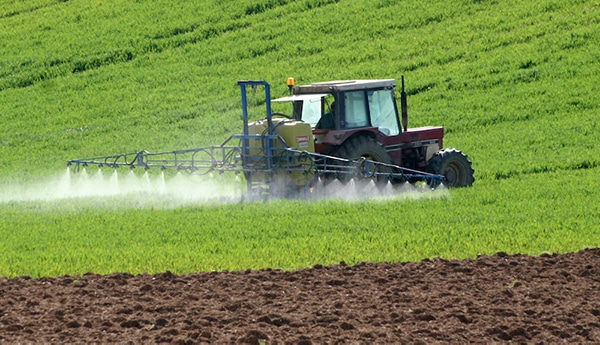Between 2011 and 2016, workers on farms represented two out of five work-related electrocutions due to contact with overhead powerlines, with one of these fatalities involving crop spraying booms/pipes.
Further, in 2016-17 there were at least 70 incidents where agricultural equipment including tractors, harvesters, slashers, spray rigs and irrigation equipment came into contact with overhead powerlines, with a seasonal peak in incidents when crops such as cane and grain are harvested.
Working near powerlines can be fatal. Touching them or straying into the exclusion zone around them can result in a serious electric shock.
The risks
Sometimes overhead powerlines are difficult to see in the landscape even on a bright sunny day, and more so in low light, in rain, cloudy weather, or at dawn or dusk.
They can also sag between poles as much four metres below the cross-arms supporting them, and sway in the wind, so what appears to be a safe working distance may later expose you, your family, workers or property to serious risks.
Electrical incidents on farms often involve contact between machinery or irrigation pipes with overhead powerlines, a lack of electrical equipment maintenance and unauthorised electrical handy-work. Apart from death and injury, electrical incidents can also cause costly property damage.
Tips to improve electrical safety
If you have powerlines on or near your property, you need to determine the height and reach of all machinery and plant used near powerlines and consider the way it is used to identify hazardous situations. Plant and machinery such as irrigation pipes, grain augers, elevators, grain silos, cranes and excavators all have the potential to contact powerlines.
Here is a simple guide to working near overhead powerlines on your farm, to ensure your safety, as well as your family, friends and workers.
- Identify overhead and underground powerlines by consulting maps and/or talking to the property owner and electrical entity.
- Conduct a site specific risk assessment – think about the type of plant and equipment/tools used, nature and size of loads being moved, site and weather conditions, type of work being done, and set-up and pack-up procedures.
- Put risk controls in place – the most effective way of controlling the risk is to de-energise the line for the duration of work where there is a risk of contact.
- Before work begins, ensure vegetation isn’t hiding powerlines from view.
1. Develop a safe system of work
before you start
- Induct and train your workers and contractors in safe work procedures, emergency procedures, and exclusion zones (Figure 2).
- Carefully plan the tasks to be completed near powerlines and work away from them whenever possible, not underneath them.
- Show your workers the safe distance from an exclusion zone by marking it on the ground.
- Ensure people are aware that powerlines sag or sway in hot or windy weather (Figure 1).
- Harvesters, elevated work platforms, irrigation pipes, grain augers, elevators, mobile grain silos, cranes, tippers and excavators have the potential to enter exclusion zones. Ensure your operators know the height and reach of machinery or hand held items to be used.
2. Keep your workers and contractors informed about electrical safety
- Make powerlines and poles visible. Ask your electrical entity for permission to paint power poles and/or have them install markers or flags on the powerlines.
- Lower toppers, harvesters and elevators when moving equipment to avoid contact with powerlines.
- Use a safety observer to make sure you stay well clear of exclusion zones.
- Where possible, use insulated or non-conductive tools and equipment.
- Follow the
3. Avoid going into exclusion zones
Solar energy
Solar power systems can present a serious electrical risk. It is best to leave all solar power system maintenance work to electricians and installers.
If you do any general maintenance activity near solar power systems, take particular care around the supply cables running from the panels on or in the roof to the inverter unit, as they will be live when the solar panels are generating electricity.
If you go up into your ceiling space, remember that even if you turn off all the main power switches at the switchboard first, the cables from the solar power system going to the inverter, and the main power supply entering your house from the street to the switchboard will still be live.
Never perform your own electrical work
People who perform unlicensed and do-it-yourself electrical work potentially risk contact with electricity while performing the work, which can have deadly consequences. The electrical installation or equipment affected may be unwittingly left in an unsafe state. The danger may not be immediately apparent, often only becoming evident in a fault situation, or it may develop over time.
Major property damage from an electrical fire is also a real risk which can impose considerable financial, emotional and social costs, especially if it was the result of illegal electrical work, which may lead to an insurer refusing a claim.
Performing your own electrical work is illegal and may invalidate your insurance. Installing or repairing electrical equipment or cables must only be done by a licensed electrician. Even when you think you know what you are doing, never attempt to do your own electrical work – it’s dangerous, illegal and can be fatal.
More information
Employers and workers should read the Electrical Safety Code of Practice 2010 – Working near overhead and underground electric lines.
For more information, visit electricalsafety.qld.gov.au
Further assistance can also be provided by:
Ergon Energy, aergon.com.au , 13 74 66
Energex, energex.com.au , 13 12 53
Dial Before You Dig, 1100.com.au





